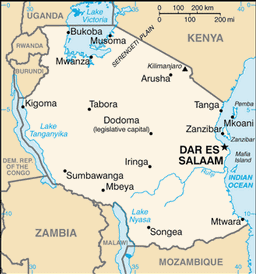Moshi, Tanzania



Moshi is a Tanzanian town with a population of 144,739 (2002 census). The town is situated on the lower slopes of Mt Kilimanjaro, a volcanic mountain which is the highest mountain in Africa.
Moshi is home to the Chagga and Maasai tribes. The city comprises two major roads, based around the central reference point of clock tower, the north-south road to Tanga and Dar es Salaam and an east-west road to Arusha.
Education
Thanks to the government, local authorities, and Catholic and Lutheran missions, Moshi has universal primary education[citation needed] and the highest literacy rate in the vicinity.[citation needed]
Moshi Municipality contains various schools including Mawenzi Secondary School, International School Moshi, Moshi Technical School and Kibo Secondary School.
The Valley View Primary and Secondary School is a private school with an English medium. It is considered to be one of the best schools in the region, even though there is a serious lack of books and utilities, partly because of a computer lab it has donated by some Americans. Because electricity in the area is unreliable, using the computers is a difficult task. Moshi Secondary School, which was formely known as Old Moshi Secondary School, is one of the two earliest government secondary schools in Tanzania, the other being Tabora Boys Secondary School.
Mawenzi Secondary School started out as the Indian School of Moshi in 1956. It is now a thriving school of 1100 pupils. A-Level students are all female boarders and are drawn from all over Tanzania. The school specialises at A-Level in Kiswahili, Geography, History, and English. The school operates a double shift system for junior pupils (Form 1 - 4). All subjects are taught in English, apart from Kiswahili and French. Mawenzi School has had a link with Buckie High School in Scotland since 1987. Pupils and teachers have travelled between Tanzania and Scotland on many occasions. There are also various English Academic Schools with primary, secondary and high school education i.e Northern highland and Eden Garden schools.
Medical Care
The main hospital in the area is the Kilimanjaro Christian Medical College. This huge spawling complex serves a population of over 11 million individuals. It was opened in March 1971 by the Good Samaritan Foundation.
More recently set up, next to KCMC is the newly formed Kilimanjaro Center for Community Ophthalmology, which is independently run by Paul Courtright, a PHD in epidemiology, and Susan Lewallen an MD with years of medical experience in Africa. In 2007, they finished construction of a new building, funded by large organizations (e.g. SEVA and Google.org) and individuals. The KCCO mostly advises the Eye Center at KCMC, and runs lots of Direct Referral Sites (DRS) to help bring patients to KCMC.
There is also Mawenzi Hospital where they have a student learning program in their Physical Therapy department in cooperation with Norway, in which Norwegian physiotherapy students in their second and third years come as short term apprentices.
Other Institutions & Establishments
Moshi Municipality has other institutions/establishments such as the Small Industries Development Organization (SIDO-Moshi), Kilimanjaro Industrial Development Trust (KIDT), Furniture Industry Training Institute (FITI), Mawenzi Regional Hospital, The Moshi Memorial Stadium and a small airport.
Tourism
Moshi is often overlooked as a tourist destination, with many visitors to Northern Tanzania instead choosing to stay in nearby Arusha. However the town is now host to the Kilimanjaro Marathon which is rapidly growing in popularity and there are several cultural tourism programs operating on the lower slopes of Kilimanjaro. Moshi also serves as the base for many expeditions up nearby Mt. Kilimanjaro, with many climbers staying in nearby hotels and employing locals as guides, porters and cooks.
Industry
There are also a number of manufacturing industries including Bonite Bottlers (carbonated drinks), Kibo Breweries (beer), Malt plant (malt for breweries) Union Service Stores (grain flour and animal feeds) and Imara (furniture). There are several metalworking workshops such as Simon Engineering, Press Forge and CFW Moshi.
Agriculture
Because of its lower altitude with less rains, the main crops grown on the higher slopes of Mt Kilimanjaro (bananas and coffee) do not thrive well there, so the outskirts of Moshi are famous for extensive farms of maize and beans, grown once per year, during the rainy season (masika). they like to have rice.
Moshi was where the Arabica coffee seeds that Catholic missionaries introduced at the end of the 19th century were cultivated. The Kilimanjaro Native Cooperative Union (KNCU) was probably the most efficient and progressive cooperative organization in Africa. The district commissioner, Sir Charles Dundas, started it in the 1920s to enable Chagga coffee growers to compete on equal terms on world markets with the European growers.
External links
- International School Moshi
- KCMC Hospital Moshi
- Kiliweb-Portal of Moshi
- Kilimanjaro Marathon
- Adventure Alternative; Medical Electives PDF
- [1]
- [2]
- The Watering Hole
The WikiProject banner below should be moved to this article's talk page. If this is a demonstration of the template, please set the parameter |category=no to prevent this page being miscategorised. |
| Missing encyclopedic articles | ||||
| ||||
